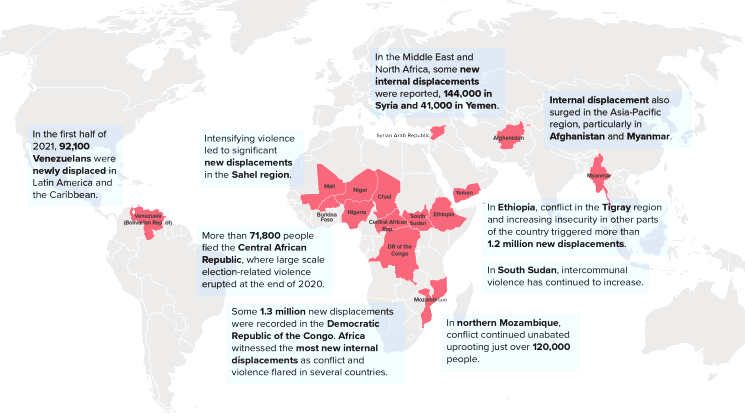Social Justice
Internal Displacement
- 16 Nov 2021
- 6 min read
Why in News
According to a report (Mid-Year Trends 2021 Report) by the United Nations High Commissioner for Refugees (UNHCR), nearly 51 million people were internally displaced across 33 countries due to conflict and violence in the first six months of 2021.
- The combination of conflict, Covid-19, Poverty, Food insecurity and the Climate emergency has compounded the humanitarian plight of the displaced, most of whom are hosted in developing regions.
- Africa is the region that is most vulnerable in terms of the numbers of displaced persons.
Key Points
- Internal Displacement (Meaning):
- Internal displacement describes the situation of people who have been forced to leave their homes but have not left their country.
- Factors of Displacement: Millions of people are uprooted from their homes or places of habitual residence each year in the context of conflict, violence, development projects, disasters and climate change and remain displaced within their countries’ borders.
- Components: Internal displacement is based on two components:
- The person’s movement is coerced or involuntary (to distinguish them from economic and other voluntary migrants);
- The person stays within internationally recognised state borders (to distinguish them from refugees).
- Difference from Refugee: According to the 1951 Refugee Convention, a “refugee” is a person who has been persecuted and forced to leave his native country.
- A precondition of being considered a refugee is that a person crosses an international border.
- Unlike refugees, internally displaced people are not the subject of any international convention.
- At the international level, no single agency or organisation has been designated as the global lead on protection and assistance of internally displaced persons.
- However, there are United Nations Guiding Principles on Internal Displacement.
- Challenges Faced by Internally Displacement Persons (IDPs): IDPs can live under threat of physical attack, sexual- or gender-based violence, and run the risk of being separated from family members.
- They are frequently deprived of adequate shelter, food and health services, and often lose their property, land or their access to livelihoods.
- Internal Displacement in India:
- Extent: Estimating the number of IDPs in India is problematic, as regular monitoring is not possible in such a huge country which lacks a central authority responsible for coordinating data from central and state governments.
- Nearly five million people were displaced in India in 2019 - the highest in the world so far - according to ‘The Global Report on Internal Displacement (GRID 2020)’.
- Policy Framework: India has no national policy and legal institutional framework to deal with either refugees or IDPs.
- India has not ratified the 1951 Convention and 1967 Protocol and does not permit UNHCR access to most refugee groups.
- In the absence of a permanent institutional structure to oversee refugee issues, the granting of refugee status has been at the discretion of the political authorities.
- Factors of Internal Displacement in India:
- Secessionist Movements: Since independence, north-east India has witnessed two major armed conflicts – the Naga movement and Assam movement.
- Jammu & Kashmir’s war between state forces and militants, had led to mass exodus of the Kashmiri Pandits.
- Identity-based Autonomy Movements: Identity-based autonomy movements, such as in Bodoland, Punjab, Gorkhaland and Ladakh, have also led to violence and displacement.
- Localized Violence: Internal displacement has also arisen from caste disputes (as in Bihar and Uttar Pradesh), religious fundamentalism and the ‘son-of-the soil policy (aggressive denial of residency and employment rights to non-indigenous groups).
- Environmental and Development-induced Displacement: In order to achieve rapid economic growth, India has invested in industrial projects, dams, roads, mines, power plants and new cities which have been made possible only through massive acquisition of land and subsequent displacement of people.
- Secessionist Movements: Since independence, north-east India has witnessed two major armed conflicts – the Naga movement and Assam movement.
- Extent: Estimating the number of IDPs in India is problematic, as regular monitoring is not possible in such a huge country which lacks a central authority responsible for coordinating data from central and state governments.
Way Forward
- Need for Policy Framework: India needs to formulate migration centric policies, strategies, and institutional mechanisms in order to ensure inclusive growth and development and reduce distress induced migration.
- Providing Justice: The government at Centre needs to provide amenities and social securities for Internally displaced population, which is riddled with the issues of inadequate housing; low-paid, insecure or hazardous work; extreme vulnerability of women and children to trafficking and sex exploitation etc.





